(Afghan Hound Database and Breed Information Exchange)
(By Steve Tillotson May 2013)
 |
(Right) Begum, Breeder Mr Abrams, de Flandre USA, 11/2/1932
Discussion on pedigrees continued..
Studying the photographs and pedigrees above is very interesting. Putana de Flandre's pedigree is short and simple. Its 50/50 Ghazni/Bell Murray, effectively an outcross. Such a breeding would likely produce one of several outcomes, and in the case of Putana de Flandre's, this hound seems to have inherited the Bell Murray phenotype.
The pedigree of Begum is especially interesting. At first glance it appears to be a half brother - half sister mating, the common ancestor being Mustavfi Of Ghazni. So should we have expected a dominance of Ghazni type arising from this mating? Looking deeper into the pedigree, we observe that the grand-dams (Cupra and Tarza) are "almost" half-sisters. Had the grand-dam's been the same then we would have had a full half sibling common ancestor situation here also. However, going back to the 4th generation, we observe that Cupra and Tarza have exactly the same four Gt Gt Grandparents (Taiza, Nurm, Ooty, Pushum), which are all Bell Murray. Effectively perhaps, Cupra and Tarza would contribute to the breeding pretty much as if they were half siblings? So we (perhaps) have a situation with Begum that we pretty much have a 50/50 Ghazni/Bell Murray breeding, and we would expect one of several outcomes as we mentioned in the case of Putana. In the case of Begum, this hound seems to also have inherited the Bell Murray phenotype.
Without seeing the rest of the littermates, it's hard to draw any firm conclusions on such 50/50 breedings. But I think what we can take from this is that it is self evident that two matings between Ghazni/Bell Murray produced good examples of Bell Murray lookalikes.
We have few photographs of such breedings. In an earlier breeding, Sirdar of Ghazni was mated to Begum's grand-dam (Tarza) and that produced the aforementioned Nush-Ki Of Ruritannia, and we do have a photograph of Nush-Ki. It's difficult from the angle of the photograph to make out some detail. One thing that is very obvious is the heavy weight of coat (which would have come from Sirdar). So here we have an example of a 50/50 Ghazni/Bell Murray offspring displaying a characteristic of the sire (Ghazni) side. Photo courtesy of David Paton/AHA Archives/Pam Croft Afghan Hound International.
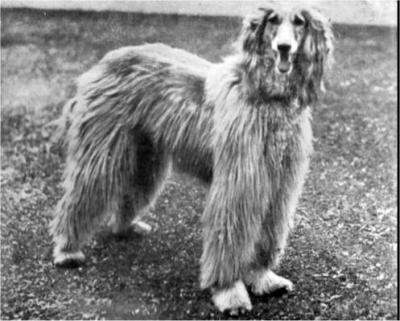 |
Mrs M B Cooper also used Mrs B de la Motte's Afghanistan import dog Shahzada (Razmak of) on a Bell Murray bitch (Cupra) that Mrs M B Cooper owned (eventually Cupra was transferred to Mrs Drinkwater and became an important brood bitch for Mrs Drinkwater's Geufron kennel). The Shahzada/Cupra litter included Nullah De Flandre, a gold dog, also exported to Mr Abrams in the USA. No photographs of Shahzada (Razmak of) apparently exist, but he was advertised at stud as being large, producing large get, and producing red offspring, he was apparently cream coloured. The assumption is that he was most probably of the Zardin type, heavier coated and with more substance than the lightly coated racier Bell Murrays.
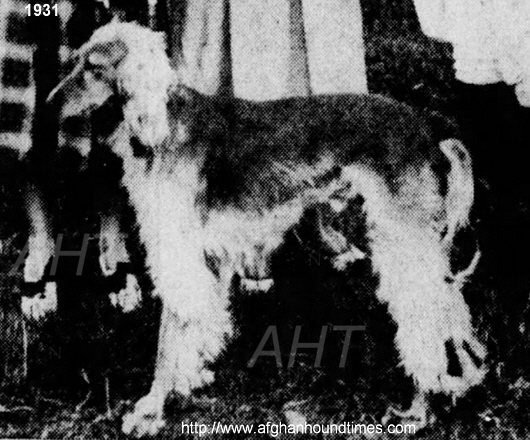 |
There is a theme emerging in Mrs M B Coopers breeding program - the mating of heavier coated, more substance dogs to lighter coated racier built Bell Murray bitches. We can be cynical and assume Mrs M B Cooper was seeking to increase coat, as many Bell Murray breeders did by crossing with Ghazni lines, or we can assume she was seeking other attributes, such as more substance. Mrs Cooper used the top Ghazni dog (Sirdar) and his descendents on her bitches, and it was only her final litter in which she did a Ghazni/Ghazni breeding. All these years later we can only guess as to what her breeding objectives were. My guess is that because Mrs M B Cooper persisted in using Bell Murray bitches she must have liked the Bell Murray type, but was seeking something additional (coat? substance?). The fact that she eventutally turned to Ghazni/Ghazni may be an indicator that she had difficulty achieving her goals with any consistency?
Perhaps one thing we learn from Mrs M B Cooper is that she faced the problem of bringing together two entirely different types of Afghan hounds and trying to blend them together in order to presumably keep the characteristics of one, whilst improving her stock by caputuring characteristics from the other type. One of the Shahzada/Cupra litter bred by Mrs M B Cooper, (Mumti Of Geuffron) became the foundation bitch for Mrs Drinkwater who's Geufron line is probably the most important and successful of those breeders who blended the different types. Mrs M B Cooper was one of the first to blend the different types and laid the ground out for others.
Some of Mrs M B Cooper's de Flandre hounds are (wrongly) reputed to have produced several "blue" Afghan hounds, one such afghan - Kush De Flandre was exported to Mr Abrams in the USA. However further research has cast doubt on the validity of the supposed "blue" registrations. A difficulty is that pre WWII the word "chinchilla" was often used by UK breeders to describe a blue dog and also a "grey" coloured dog was often mis-described as blue. "Blue" in afghans is often accompanied by a particular coat pattern which probably led to it being called as Chinchilla in the early days
In "Pure-bred dogs, American Kennel gazette: Volume 72, Part 1" dated 1951 Phyllis Robson wrote - "The confusion over colour naming in this breed is quite understandable. We have so many colours with so many intermediate shades, and frequently unusual variations. The poor breeder, in listing the colours of a litter, is almost certain to have trouble distinguishing between shades like red and fawn - and if the the puppies are young, he may be able to make only the wildest guess at the eventual colour of the dog. The import Tazi of Beg Tute must number a goodly number of solid greys or blues amongst their may descendants. The other early import was a dog named Kush De Flandre, described as "blue grey". If he was not a brindle, then he is the only instance I know of in which the solid grey emerged from exclusively Ghazni and Bell Murray lines"
AHT UPDATE 2/26/25 - Since we wrote the original above we have obtained some further information about de Flandre and the Grey colour. First of all view the press clipping below -
 | Litter Born 6/8/1926 - Shahzada x Cupra Nullah De Flandre Dog Gold Mumti Of Geufron Bitch Bul Bul de Flandre Dog Bibianne de Flandre Bitch Beni de Flandre Dog The Black Prince de Flandre Dog |
An interesting snippet from the press cutting above is Mrs Cooper's statement that the bitch she is discussing was coloured "grey", so we have an instance, first hand, of the breeder confirming the colour grey in this early litter. The bitch in question is Bibianne de Flandre because the only other registered bitch in the litter went to Mrs Drinkwater of Geufron. Noting Phyllis Robson's comment above about no known instances about solid grey emerging from Ghazni/Bell Murray lines - well this breediing involved Shahzada/Afroz , mated to a Bell Murray Bitch (Cupra). So perhaps the solid Grey colour first emerged in the uk via ShahzadaAfroz lines?
Mrs Amps (Ghazni) wrote in 1932 - "Monsieur Hackin, the well-known French archaeologist and Buddhist authority of the Guimet Museum, Paris, who had exceptional opportunities of traveling in the lesser known parts of Afghanistan, told us of a pack of chinchilla hounds, grey with black points, kept by a Governor of a district near the Oxus, if hounds of any other colour are born, they are thrown out of the pack, and, being greatly sought after by the Afghan shikaris, find their way as far south as Ghazni and Kabul. Khan Of Ghazni, a fine, honey-fawn coloured hound, imported into this country in 1925, came from this pack. I had one perfect chinchilla bitch sired by him and I understand that a son of his, Mustavi Of Ghazni, the property of Mrs Cooper, also sired a number of chinchilla hounds".
Kush De Flandre, as we can see in the above pedigree was the sire of Begum. We also note that a littermate to Begum - Ahmed Shah Durani Of Kingway was sold to Mrs William Porter of Denver, Colorado, who started her "Kingway" Afghan hound kennel in 1933.
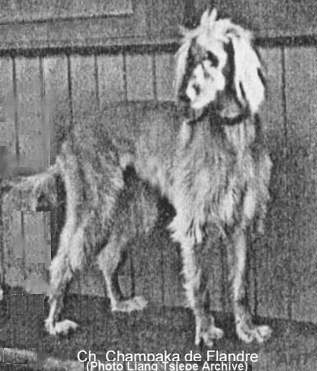 |
We should mention Champaka De Flandre, a littermate of the Mustavfi Of Ghazni and Cupra litter bred by Mrs M B Cooper. Champaka was exported to Mrs S N Liese-Terstall (Liang Tsjeoe Afghan Hounds, Netherlands). Liang Tsjeoe kennel started breeding with their imported Cove (Jean Manson, Bell Murray) Afghans as early as 1926, they added the de Flandre lines shortly after and incorporated them in their breeding program. Whilst the Champaka de Flandre export does not contribute to active pedigree history, the exports were an interesting part of the Dutch breed development.
We also mention Rajah Secundos Of Cove who was exported to Mrs S N Liese-Terstall (Liang Tsjeoe) in the Netherlands who was mated to Champaka and produced a couple of litters for Mrs S N Liese-Terstall. Liang Tsjeoe was the second kennel in the Netherlands that imported and bred Afghan Hounds, pre-dating Van de Oranje Manege by several years. We will provide a separate section on Liang Tsjeoe kennels shortly
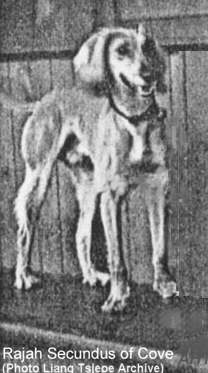 |
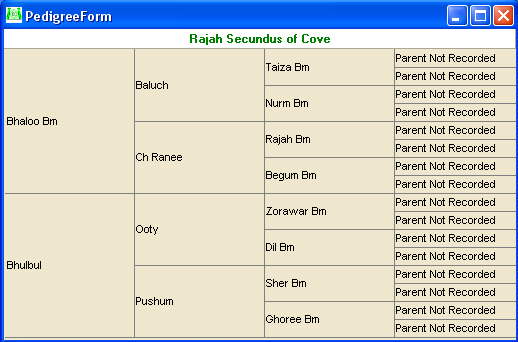 |
Some on-line records wrongly list Champaka as having produced blue Afghan hounds for the Dutch kennel. This is incorrect. We have been provided with full litter details for all the Liang Tsjeoe breedings by a custodian of Liang Tsjeoe archives and none of the Liang Tsjeoe afghans were registered blue. The error appears to be a mis-translation of the word "grey" in the Dutch language that ended up being translated to blue in the English language.
So all in all - a blender of foundation bloodlines, exporter of Afghan hounds to Europe and the USA, thats a pretty impressive record for the small de Flandres (UK) kennel.
Previous de Flandre Page
Related content:
The Afghan Levrier 1927 by Mrs M B Cooper (de Flanders Afghan Hounds, UK
Early Afghan Hounds Section
The Origins Section
Library Of Articles/Main Menu Toolbar